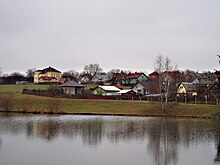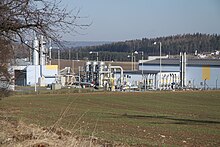Háje u Příbramě
| Háje | ||||
|---|---|---|---|---|
|
||||
| Basic data | ||||
| State : |
|
|||
| Region : | Středočeský kraj | |||
| District : | Příbram | |||
| Area : | 663.5018 ha | |||
| Geographic location : | 49 ° 40 ' N , 14 ° 3' E | |||
| Height: | 575 m nm | |||
| Residents : | 467 (Jan. 1, 2019) | |||
| Postal code : | 261 01 - 262 14 | |||
| License plate : | S. | |||
| traffic | ||||
| Street: | Příbram - Kamýk nad Vltavou | |||
| structure | ||||
| Status: | local community | |||
| Districts: | 1 | |||
| administration | ||||
| Mayor : | David Lukšan (as of 2015) | |||
| Address: | Háje 39 261 01 Příbram |
|||
| Municipality number: | 598402 | |||
| Website : | www.haje-obec.cz | |||
Háje (German Haje ) is a municipality in the Czech Republic . It is located three and a half kilometers southeast of the city center of Příbram and belongs to the Okres Příbram .
geography
Háje is located in a shallow hollow in the Příbramská pahorkatina ( Příbram hill country ). The village is surrounded in the west, north and east by disused mining facilities of the Příbram uranium mines ( Uranové doly Příbram ). The Vršce (603 m nm) and the Skleněný vrch rise to the north, the Vysoký (583 m nm) to the east, the Ryšavý (599 m nm) and the Levín (612 m nm) to the south, the Jestřabinek (590 m nm) to the southwest ), west of the Holanec and the cone slope Šachta 9 and in the northwest the Svatá hora ( Holy Mountain , 586 m nm). To the northeast is the Příbram prison, to the east is the Háje u Příbrami underground gas storage facility ( Podzemní zásobník zemního plynu Háje u Příbrami ). On the northern outskirts of the village the road II / 118 runs between Příbram and Kamýk nad Vltavou , one kilometer east the road I / 4 between Milín and Dubenec passes Háje.
Neighboring towns are Haťská Chalupa, Nová Hospoda and Dubno in the north, Bytíz, Drásov and Buda in the northeast, Placy, Jelence and Jablonná in the east, Horní Hbity, Káciň, Na Pelechu, Stěžov and Palivo in the southeast, Jesenice and Jerusalem in the south, Brod in the South-west, Hatě and Sázky in the west and Lázně, Svatohorský Důl, Svatá Hora, Příbram III and Příbram IX in the north-west.
history
The first written mention of the village Nová Ves na Hájích , which was subject to the Dobříš rule, was made in 1603. On June 14, 1630, the Bohemian Chamber sold the Dobřisch rule with the attached Heiligfeld estate with the exclusion of red deer and wild boar hunting to the chief hunter Kingdom of Bohemia, Bruno von Mansfeld and Heldrungen . The next owner was Franz Maximilian von Mansfeld . Until 1714 the village belonged to the Podbrder district, after which it became part of the Berauner district . After the male line had died out in 1780 with the death of Joseph Wenzel von Mansfeld , his sister Maria Isabella inherited the Dobřisch rule. The name and coat of arms were merged with the family of her husband Franz de Paula Gundaker von Colloredo-Waldsee-Mels to the Colloredo-Mannsfeld family . After Maria Isabella's death in 1794, her son Rudolph Joseph II inherited the property. After the death of the childless Rudolf Joseph II von Colloredo-Mannsfeld, the rule fell to his nephew Franz de Paula Gundaccar II von Colloredo-Mannsfeld in 1844 .
In 1846 Haje consisted of 28 houses with 226 inhabitants. The parish was Sliwitz ( Slivice ). Until the middle of the 19th century, Haje remained subject to the Dobřisch rule.
After the abolition of patrimonial formed Háj / Haj 1850 a district of the municipality Konětopy in the judicial district Příbram. From 1868 the village belonged to the Příbram district . On December 2, 1872, the Bohemian Parliament approved the separation of the places Háj and Bytíz from the Konětopy commune and the formation of the Háj commune. Háje has been used as a place name since the end of the 19th century. In 1907 a school opened in Háje. Bytíz broke away from Háje in the 1920s and joined the municipality of Dubenec as a district . In 1932 318 people lived in Háje. In the second half of the 20th century, the area around Háje formed one of the main mining areas of the Uranové doly Příbram . The Šachta 16, sunk in 1957 , ultimately reached a depth of 1,838.4 m and is considered the deepest shaft in Central Europe. At the beginning of 1975 Háje was incorporated into Příbram. The municipality of Háje has existed again since November 24, 1990. After the cessation of uranium mining , the Příbram prison was built in the opencast mine at Šachta 11 near Bytíz in the 1990s. After the Šachta 16 mine was closed in 1991, the following year the expansion work began to use the mine as a storage facility. Underground gas storage began in 1998, operated by RWE Gas Storage.
Community structure
No districts are identified for the municipality of Háje. The disused mines Šachta 9, 13 and 16 as well as parts of Šachta 11 and 21 are located in the municipality.
Háje is part of the cadastral district of Háje u Příbramě . This is a peculiarity because, in addition to Háje, it also includes the Příbram districts of Jerusalem and Jesenice. This contradicts the municipal law ( Zákon o obcích ), which excludes the division of a cadastral district into several municipalities.
Web links
Individual evidence
- ↑ http://www.uir.cz/obec/598402/Haje
- ↑ Český statistický úřad - The population of the Czech municipalities as of January 1, 2019 (PDF; 7.4 MiB)
- ↑ Johann Gottfried Sommer The Kingdom of Bohemia, Vol. 16 Berauner Kreis, 1849, p. 232
- ↑ http://www.psp.cz/eknih/1872skc/1/stenprot/021schuz/s021003.htm
- ↑ http://www.rwe-gasstorage.cz/cs/haje/




